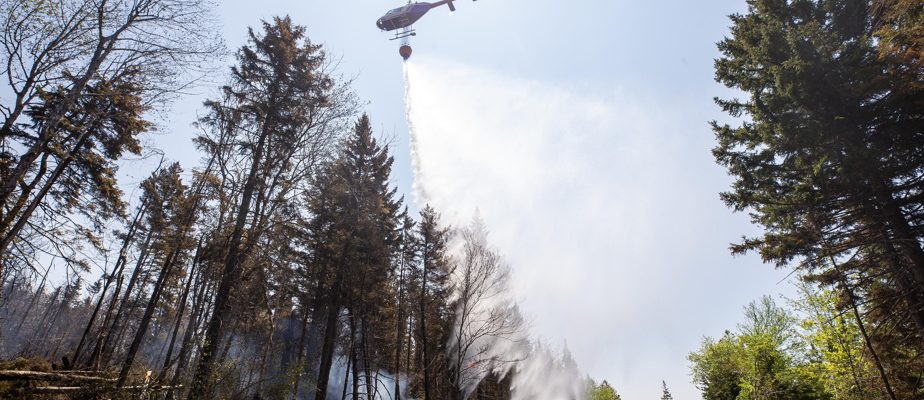(Halifax) Heavy rain and military reinforcements arrived Saturday to help smother wildfires that have destroyed homes and forced the evacuation of thousands of people across Nova Scotia.
The major wildfire that has ravaged 150 homes near Halifax, Nova Scotia, is 85% contained and no longer gaining ground, according to local authorities.
News was also good across the province, where Premier Tim Houston said the total number of active wildfires had fallen from 10 in the morning to five by mid-afternoon.
“If you go out, you will see something beautiful: rain, and I hope a lot,” he said during a Saturday afternoon briefing.
The only fire that remains out of control is the one in Shelburne County in the southwest corner of the province – the largest in Nova Scotia history – which remains “frightening”, Houston said.
Meanwhile, at the provincial forest fire center in Shubenacadie, north of Halifax, about 20 Canadian Armed Forces soldiers stood in the pouring rain outside a light armored vehicle (LAV).
Lieutenant-Colonel Michael Blanchette said the initial contingent from Canadian Forces Base Gagetown, New Brunswick, had arrived on a “fact-finding mission” to see what military support was needed in the effort to combat fires.
He explained that the armored vehicle has a thermal targeting system which could be able to detect hidden hotspots, especially at night, while soldiers can provide a “low level firefighting capability”. , such as the elimination of smaller hot spots after the passage of firefighters.
Mr. Blanchette said that the military in Atlantic Canada used to be called out for floods and winter storms, but that he had never responded to a forest fire before. “It’s a first time for us,” he said.
The renewal of the flames is not excluded
David Steeves, a technician with the province’s Department of Natural and Renewable Resources, told reporters Saturday morning that the fire is concentrated in an area of 9.5 square kilometers and is not expected to grow any further.
The efforts to fight the blaze, combined with the return of the rain, would explain this good news.
“We are slowly going from being out of control to being under control,” said Mr. Steeves. What this means is that with the resources that are currently on the ground and the firefighting efforts that have already taken place, the fire should not spread further. »
Despite everything, Mr. Steeves recalled that the situation remains worrying in many sectors. Crews continue to carefully monitor the perimeter of the fire and hot spots, while a resurgence of flames in some places is not excluded.
He explained that the fire was far from extinguished and that embers could still hide deep in places where rain does not penetrate, posing a risk of re-ignition.
“We could be here for several weeks, even months, before our commander is comfortable declaring the fire extinguished,” he warned.
The fire that broke out in the Halifax area last Sunday swept through a number of residential areas, burning around 200 structures – including 151 homes – and prompting the evacuation of more than 16,000 people.
Environment Canada meteorologist Bob Robichaud said between 25 and 50 millimeters of rain fell in parts of the province on Saturday, adding that temperatures had also cooled. He said the air quality in most affected areas has also improved significantly.
Halifax Deputy Fire Chief David Meldrum said rain relieved firefighters on Saturday. However, he pointed out that precipitation could also complicate their mission by causing falls.
“They’re going to be very dirty, very wet and they’re going to be cold,” he said. We are happy for the return of the rain, but it will not be an easy day for our firefighters. »
Meldrum said two firefighters had previously been injured by heat stress and another had hit his head while moving equipment.
Historic season
Despite this positive news about the state of the fire, thousands of evacuees will have to wait a little longer before they can return to their homes.
The evacuation order was lifted in some areas that were not affected by the fire late Friday, but Mr Meldrum warned that there were still checks to be made to ensure that the other evacuated areas are safe for returning residents.
The city said Saturday that residents may not be able to return to the worst-hit area for 10 to 14 days.
In Shelburne County, 6,700 people – around half the municipality’s population – remained out of their homes as the blaze that forced their evacuation continued to spiral out of control.
The Barrington Lake Wildfire, which started on Saturday, has grown to 230 square kilometers – the largest recorded wildfire in the province’s history. It consumed at least 50 homes and cabins.
Nova Scotia is experiencing one of the worst wildfire seasons in its history, with 11 active fires in the province as of Friday evening.
A spokesman for the Department of Natural Resources, Dave Rockwood, said he was rather optimistic, but cautious, that there would be no more growth and that firefighters could use more direct tactics to contain the fire. As of Saturday morning, two other fires deemed uncontrolled were classified as “under control” later in the day, he added.
Premier Houston confirmed that schools in Shelburne County will be closed Monday and Tuesday.
A contingent of 17 firefighters from the northeastern United States also arrived at the wildfire center later Saturday, where they were briefed before being deployed to assist with firefighting efforts.
